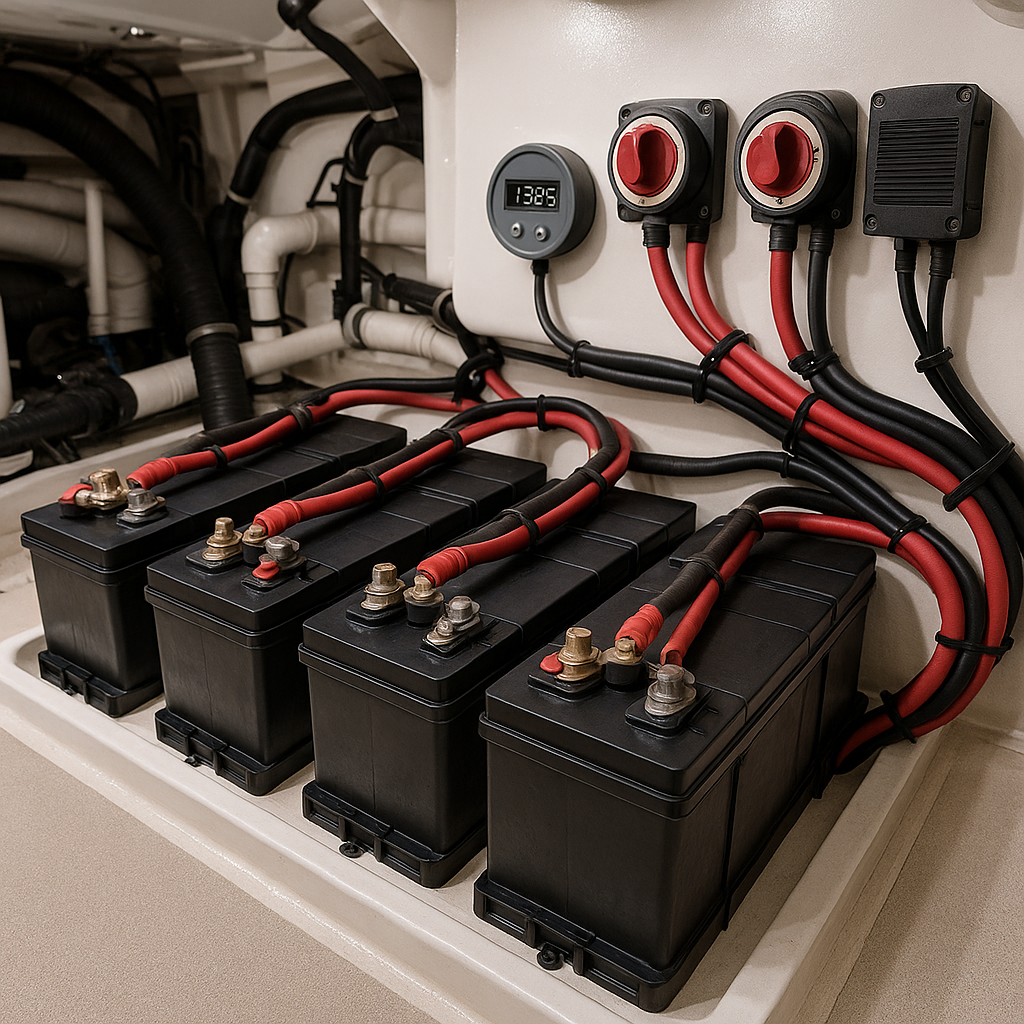Yacht batteries don’t just sit quietly below deck. They work every hour, powering everything from navigation to air conditioning. In Miami, the heat and saltwater never let up. Battery banks take the brunt of it. Ignore them, and you risk losing power when you need it most. Reliable batteries keep the trip going. Weak batteries cut it short.

What Happens When Battery Banks Slip
Lights flicker. The engine hesitates. Electronics reset without warning. These aren’t small annoyances—they’re the first signs your battery bank is struggling. Miami’s climate speeds up every problem. Salt creeps into connections. Heat dries out cells. Moisture builds up in tight spaces. Corrosion spreads fast. A single weak cell drags down the whole bank. One overlooked battery can leave you dead in the water.
- Engine cranks slow, or not at all
- Lights dim and electronics cut out
- Batteries lose charge overnight
- Terminals show white or green crust
- Battery cases bulge or leak
- Sharp, rotten smells fill the compartment
These aren’t just warning signs. They’re red flags. When you see them, the system is already in trouble. Power drops. Safety goes with it. Miami’s waters don’t forgive electrical mistakes.
Tools That Keep You Ahead
Estimating doesn’t cut it. You need real numbers and clear alerts. Digital voltmeters show the truth about charge levels. Hydrometers reveal when a cell is dying. Battery monitors track every cycle, every drain, every recharge. Temperature sensors catch overheating before it melts a terminal. Smart chargers adjust on the fly, protecting batteries from overcharging or deep discharge.
- Digital voltmeters for instant readings
- Hydrometers to spot weak cells
- Battery monitors that log every charge and drain
- Temperature sensors for early warnings
- Smart charging systems with built-in diagnostics
Automated monitoring systems do more than beep when something’s wrong. They give you a full picture—charge status, temperature, cycle history. With the right setup, you spot trouble before it ruins a trip. Mobile marine mechanics in Miami see the difference every day. Owners with real monitoring avoid the big breakdowns.
Charging Habits That Make Batteries Last
Charging isn’t just plugging in and walking away. Miami’s heat and humidity punish batteries that sit at full charge or run too low. Multi-stage chargers adjust as batteries fill up, cutting back before damage sets in. Keeping charge levels between 45% and 85% stretches battery life. Letting them drop too low or sit at 100% shortens it. Every pre-trip check should include a look at the battery bank. Don’t trust the gauge—use a meter.
- Use multi-stage chargers for safe, even charging
- Keep batteries between 45% and 85% charge
- Never let batteries sit discharged for days
- Check charge status before every trip
- Replace chargers that show erratic readings
Charging right isn’t a suggestion. It’s the difference between batteries that last a season and batteries that last for years. Pre-trip inspections catch problems before they become emergencies.
Terminal Care That Stops Corrosion
Salt eats wires. Connections corrode. Miami’s air speeds up the process. Terminals need monthly cleaning. Baking soda and water knock back corrosion. Dielectric grease seals out moisture. Tight connections keep power flowing. Loose ones spark and fail. Terminal protectors add another layer, blocking salt spray and grime. Ignore terminals, and you’ll see power loss, heat, and even fire risk.
- Clean terminals every month with baking soda solution
- Apply dielectric grease after cleaning
- Tighten every connection—no exceptions
- Install terminal protectors for extra defense
- Replace any cable that feels brittle or looks green
Corrosion doesn’t stop on its own. It spreads. It kills batteries and electronics. Protecting terminals is a hands-on job. Saltwater damage shows up first at the connections. Stay ahead of it, or pay for it later.
Why Pro Service Makes the Difference
DIY checks catch the basics. Professionals catch what you miss. They test every cell, load-test the bank, and spot hidden faults. They see the early signs of failure—heat marks, swelling, subtle voltage drops. They know when a battery is about to quit, even if it looks fine. Miami’s marine techs bring the right tools and the right skill. They don’t guess. They know.
- Full load testing for every battery
- Infrared scans for hot spots
- Detailed reports on battery health
- Replacement recommendations before failure
- System upgrades for longer life and better reliability
Professional service isn’t just about fixing what’s broken. It’s about keeping you on the water, not stuck at the dock. The right team keeps your battery bank strong, season after season.
Get Professional Battery Service in Miami
Need specialized help with your yacht's battery systems? Contact Boat Repair Miami FL at 305-290-2705 or schedule your battery service today.






.png)